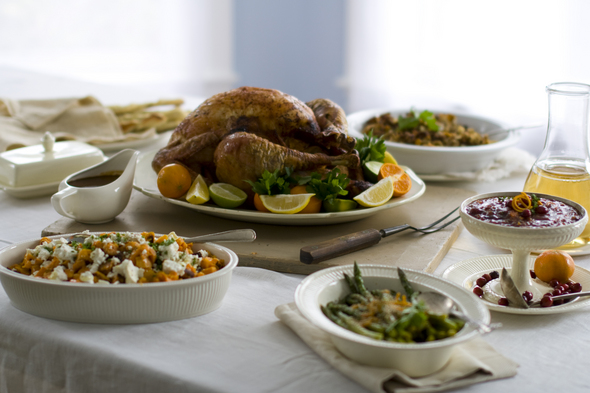Building big dinners around common flavors

This Oct. 13, 2011 photo shows a citrus turkey surrounded by side dishes in Concord, N.H. Big holiday meals can be a hodgepodge of unrelated flavors, textures and sensations. The challenge for the host is to tie it all together.
AP Photo | Matthew Mead
In Marcia Pelchat's family, every festive meal begins with chicken soup. And her grandmother's sweet-and-sour meatballs.
"We always have chicken soup, even on Thanksgiving, then we have sweet-and-sour meatballs," says the sensory scientist at Philadelphia's Monell Chemical Senses Center. "Who knows why. We just learned that they go with Thanksgiving."
Big holiday meals can be a hodgepodge of unrelated flavors, textures and sensations. The challenge for the host — especially at Thanksgiving, when the sheer volume of food is compounded by deeply held family traditions — is to tie it all together.
So how do you create harmony among otherwise dissonant dishes? The pros suggest threading a single flavor, say sage or citrus, throughout the meal.
"This technique orchestrates the meal," says Lisa Yockelson, author of "Baking Style," whose recipes build flavor by using the same ingredient in many forms, for instance, almond paste, almond meal and almond extract together. "The dinner becomes a delicious composite, rather than having to adjust your palate to too many different elements."
Flavor seems designed to encourage early humans to consume maximum calories in an uncertain world. And the greater the variety of flavors, studies show, the more people tend to eat. But in our modern, calorie-saturated world, well-fed humans have the luxury of rejecting flavors that ricochet from one end of the taste buds to the other.
"You don't want to confuse your palate," says Scott Drewno, executive chef at Wolfgang Puck's The Source, in Washington. "If you're going to do something with a bracing acid component, like ceviche, is it going to be good on the table with stuffing? They're at opposite ends of the spectrum and they're not going to pair well together."
A single, unifying flavor can end the confusion. But it also presents perils. Pelchat says that unlike the process of "sensory adaptation" — where after a few minutes you become accustomed to an aroma, say dinner cooking — human beings actually perceive a flavor or aroma more acutely when attention is drawn to it.
"It's like a melody repeating throughout a symphony," she says.
Which means the melody can clobber the diner over the head if it's repeated too often — or without the appropriate skill.
"Rather than being an easy thing to do, it's quite demanding," says Niki Segnit, author of "The Flavor Thesaurus," which arranges 99 ingredients into 1,000 flavor pairings. "You have to be sure you have the knowledge to express the flavor in different ways so your eater doesn't feel like they're eating the same thing over and over again. You have to be quite creative... It comes down to taking the ingredients and refracting the flavors in different ways."
Professional chefs do this all the time, in fact, it's a bit of a hat trick. For instance, ginger might be sauteed in a stir-fry, as well as presented pickled, as a condiment. Sage might be expressed as the underlying theme of a poultry brine, and as a brown-butter dressing for a vegetable or pasta. The Source's Drewno says he likes to pair a pork chop with pork belly laced noodles.
Michael Ruhlman, cookbook writer and author of "Ruhlman's Twenty," which focuses on essential cooking techniques, suggests showing off the versatility of turkey — and your skills — by preparing its different parts in different ways. For instance, he says, an ambitious home cook could confit the wing, braise the drumstick and roast the breast, combining the parts on each diner's plate.
"It would be an easy way for someone at home to make a statement," he says. "People would be able to think about these different textures and the different flavors we've evoked by slow-cooking in fat, slow-cooking in stock or water, and roasting." If you really want to go nuts, pluck something "from deep inside the bird," he says, like liver or gizzard, and incorporate it into a polenta.
"You'd have four different preparations from the same bird," he says. "That's just plain impressive."
Which doesn't necessarily mean you have to ditch the meatballs. While some items go together as a matter of science — for instance, the salt in cheese revealing the sweet-tart components in wine, says Pelchat — others simply pair because of culture. Segnit mentions chocolate and eggplant, a common duo in southern Italy, and cocoa in meat sauce, a South American pairing. In ethnically diverse places, such as Hawaii, the Thanksgiving turkey and sweet potatoes often are accompanied by sushi and Spam.
"I don't think it's unusual at all for Chinese families to have dumplings, or an Italian family to have pasta," Pelchat says. "Family traditions die hard. If you skip something they'll be upset."


Comments
Gordon
Mon, Oct 31, 2011 : 3:24 p.m.
OK, great article really appealing to the foodies of the world. Now, I have to have two more cooking books. I guess, not bad, compared to the cost of culinary school. I thought about making biscuits for our pot roast, now I know I have to make them. The tartness of the buttermilk pairs so nicely with the richness of the pot roast. Thanks.